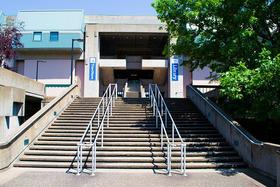School Highlights
Ross College-Canton serves 428 students (75% of students are full-time).
The college's student-teacher ratio of 15:1 is lower than the state community college average of 22:1.
Minority enrollment is 79% of the student body (majority Black), which is more than the state average of 38%.
Quick Facts (2025-26)
- Enrollment: 428 students
- In-state tuition: $12,123
- Out-state tuition: $12,123
- Student-teacher ratio: 15:1
- Minority enrollment: 79%
- Source: Integrated Postsecondary Education Data System (IPEDS)
Top Rankings
Ross College-Canton ranks among the top 20% of public schools in Ohio for:
Category
Attribute
Diversity
School Overview
The teacher population of 28 teachers has stayed relatively flat over five years.
Ross College-Canton
(OH) Community College Avg.
Carnegie Classification
Associate's Colleges: High Career & Technical-High Traditional
Baccalaureate/Associate's Colleges: Mixed Baccalaureate/Associate's
Institution Level
Less than 2 yrs
At least 2 but less than 4 years
Institution Control
Public
Private not-for-profit
Total Faculty
28 staff
93 staff
Number of Programs Offered
6
39
School Calendar
Student Body
The student population of Ross College-Canton has grown by 107% over five years.
The student-teacher ratio of 15:1 has increased from 10:1 over five years.
The Ross College-Canton diversity score of 0.76 is more than the state average of 0.58. The school's diversity has grown by 57% over five years.
Total Enrollment
428 students
757 students
Student-Teacher Ratio
15:1
22:1
# Full-Time Students
319 students
397 students
# Part-Time Students
109 students
360 students
# Enrollment Undergraduate
428 students
313 students
# Full-Time Undergraduate Students
319 students
385 students
# Full-Time Graduate Students
n/a
10 students
# Part-Time Undergraduate Students
n/a
434 students
# Part-Time Graduate Students
n/a
3 students
Total Dormitory Capacity
n/a
425 students
% Asian
6%
4%
% Hispanic
1%
6%
% Black
21%
15%
% White
21%
62%
% Hawaiian
10%
2%
% Two or more races
4%
4%
% Non Resident races
n/a
1%
% Unknown races
37%
6%
Diversity Score
0.76
0.58
College Completion Rate (Students who graduate in less than 4 years)
52%
54%
College Completion Rate (Students who graduate in 4 years or more than 4 years)
n/a
22%
Average Graduate Earnings (10 Years)
$30,300
$31,900
Tuition and Acceptance Rate
The public in-state tuition of $12,123 is more than the state average of $5,163. The in-state tuition has grown by 9% over four years.
The public out-state tuition of $12,123 is more than the state average of $10,843. The out-state tuition has grown by 9% over four years.
In-State Tuition Fees
$12,123
$5,163
Out-State Tuition Fees
$12,123
$10,843
% Students Receiving Some Financial Aid
79%
88%
Median Debt for Graduates
$22,141
$20,581
Median Debt for Dropouts
$6,625
$7,090
Acceptance Rate
n/a
73%
SAT Reading
n/a
460
SAT Math
n/a
475
SAT Writing
n/a
465
ACT Composite
n/a
21
ACT English
n/a
20
ACT Math
n/a
20
Source: 2023 (or latest year available) Integrated Postsecondary Education Data System (IPEDS)
Frequently Asked Questions
How much does Ross College-Canton cost?
Ross College-Canton's tuition is approximately $12,123 for In-State students and $12,123 for Out-State students.
What schools are Ross College-Canton often compared to?
Ross College-Cantonis often viewed alongside schools like Kent State University at Stark by visitors of our site.
What is Ross College-Canton's ranking?
Ross College-Canton ranks among the top 20% of community college in Ohio for: Diversity in US community colleges.
Recent Articles

How to Transfer from Community College to a Four-Year University in 2025
A step-by-step guide for community college students transferring to a four-year university in 2025 — updated strategies, data and expert insights.

Scholarships for Community College Students 2025
Explore updated scholarship programs, tuition data, and expert strategies for community college students in 2025.

The Rise of Technical and Vocational Training in 2025
Explore the 2025 surge in technical and vocational training—enrollment, policy, costs, and why this path is gaining ground for students and parents.






